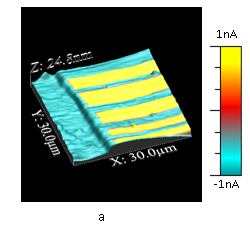Nanocoax ( metal- dielectric- metal) structures are potential devices for nanoscale photonics systems such as polarization- preserving optical waveguides for optical communication. It is very important to know the propagating properties of such structure for different excitation wavelengths.
NSOM is the best tool for study of such plasmonic nanodevices since the nSOM measurement is not diffraction-limited, and it provides both topographic and optical data with high resolution.
A Nanonics MV-4000 system was used for the AFM/NSOM measurements. This system enables scanning with probe as well as with the sample. The tip scanning capability is absolutely necessary for the study of objects requiring any form of constant optical alignment. The feedback in this system is based on the tuning fork, hence there no interference between the beam bounce laser and the light propagating through the sample.
The sample with the nanocoax array was specially prepared. The sample was illuminated from the bottom with different light sources: 473 nm, 532 nm, 660nm 850 nm. The light was transmitted through the nanocoax structures, collected via cantilevered NSOM probe (aperture diameter 100 nm), and detected with an avalanche photodiode.
Experimental results together with numerical calculations showed that the propagated modes have a different nature depending on the excitation wavelength, i.e, plasmonic TE11 and TE21 modes in the near infrared and photonic TE31, TE41 and TM11 modes in the visible. Far field transmission out of the nanocoaxes is dominated by the superposition of Fabry-Perot cavity modes resonating in the structures, consistent with theory.
In summary, propagation of the plasmonic and photonic modes in nanocoax structures was experimentally observed for the first time in this work.

Fig. 1 NSOM-measured (a - d) and calculated (f - i) images of the propagated modes in the nanocoax structure. The wavelengths were 850 nm (a, f), 660 nm (b, g), 532 nm (c, h) and 473 nm (d, i). In all cases, the polarization is in the vertical direction, the scale bars represent 200 nm and circles represent the inner and outer radii of the coax annuli. (e) Three-dimensional representation of the nanocoax topography (lower, via AFM) and the corresponding near-field intensity (upper) for 532 nm wavelength.
Published: Optics Express June 16, 2014 Vol 22, No. 12
Click here for more information on the Nanonics MultiView 4000 system





 By combining the best of both worlds that photons and electrons have to offer, polaritons hold much promise for a variety of applications in optoelectronics and nanophotonics such as miniatiruzed circuits for improved information or energy transfer. Polaritons are hybrid or quasi particles that are made up of photons strongly coupled to an electric dipole. There are different kinds of polaritons such an electron-hole pair that form an exciton polariton, which is present in semiconductors, or electrons at a metal surface that create surface plasmon polaritons (SPPs). Exciton polaritons that are stable at ambient conditions are an active area of research interest. A particular group of semiconductor chalcogenide materials was recently identified to have the existence of polaritons under ambient conditions. However, these materials were previously investigated using far-field methods. These materials are important for their potential applications in information technology, bio-sensing and metamaterials.
By combining the best of both worlds that photons and electrons have to offer, polaritons hold much promise for a variety of applications in optoelectronics and nanophotonics such as miniatiruzed circuits for improved information or energy transfer. Polaritons are hybrid or quasi particles that are made up of photons strongly coupled to an electric dipole. There are different kinds of polaritons such an electron-hole pair that form an exciton polariton, which is present in semiconductors, or electrons at a metal surface that create surface plasmon polaritons (SPPs). Exciton polaritons that are stable at ambient conditions are an active area of research interest. A particular group of semiconductor chalcogenide materials was recently identified to have the existence of polaritons under ambient conditions. However, these materials were previously investigated using far-field methods. These materials are important for their potential applications in information technology, bio-sensing and metamaterials.










